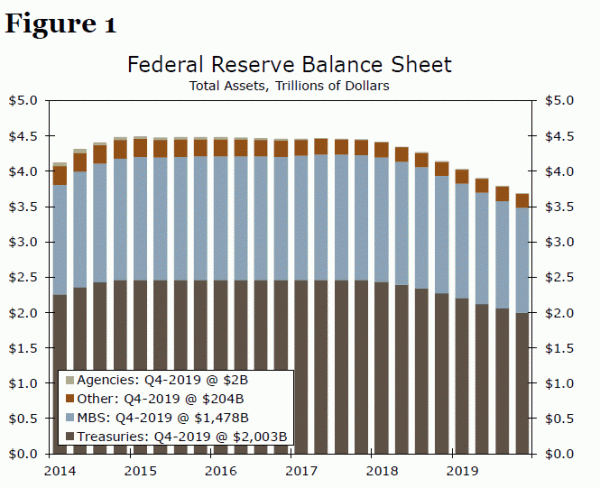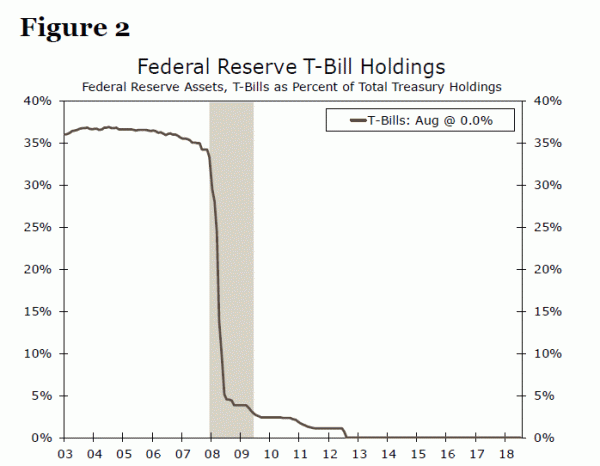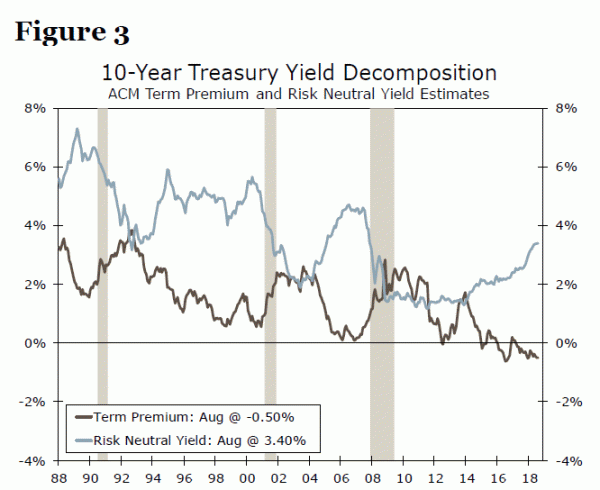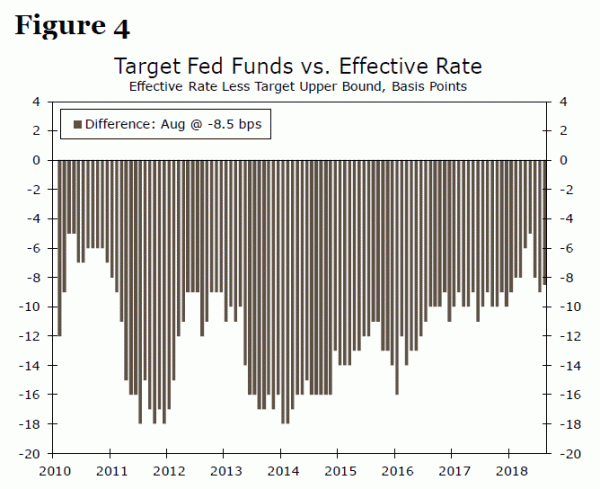Executive Summary
In part I of this two-part series, we estimated that the size of the Fed’s balance sheet would shrink to about $3.7 trillion or so by late 2019/early 2020 before it again begins to grow organically. Treasury securities and mortgage-backed securities (MBS) comprise the vast majority of the Fed’s assets. Because Fed officials have expressed their desire to eventually wind down their holdings of MBS entirely, the Fed will need to hold sizable amounts of U.S. government bonds on the asset side of its balance sheet. We forecast that yields on Treasury securities will rise in coming quarters as the Federal Reserve hikes the fed funds rate further and as Treasury issuance continues to increase. However, sizable holdings of Treasury securities by the Fed means that the level of the yield curve likely will be lower than it would be if the Fed’s balance sheet were toshrink back to more historic norms.
The Fed will also need to make some decisions about the composition of its holdings of U.S. government bonds. The weighted-average maturity of the Fed’s portfolio of Treasury securities has risen significantly in recent years, and we argue that there would be some advantage to shortening the maturity profile of the portfolio going forward. If the Fed were to pursue this strategy, then there would be some steepening pressure on the curve, everything else equal. That said, the ultimate strategy that the Fed pursues regarding the maturity profile of its portfolio still appears to be a work in progress. Stay tuned.
The Pace of Asset Reductions on the Fed’s Balance Sheet
The Fed’s balance sheet currently stands at $4.2 trillion, down from roughly $4.5 trillion in Q4-2017 when the central bank began reducing its asset holdings. Starting October 1, 2018, the Fed will allow a maximum of $30 billion a month in Treasury securities and $20 billion a month in MBS to roll off its balance sheet. Projecting the pace of redemptions of U.S. government bonds is fairly straightforward, as the maturity schedule is known in advance.
Determining the pace of MBS redemptions is a bit more complicated, however. The pace of MBS prepayments is influenced by a variety of factors, such as refinancing rates and rates at which mortgages are prematurely repaid as homeowners sell their houses and move. Using the maturity profile of the Fed’s Treasury holdings and projections made by the residential MBS research team at Wells Fargo Securities, we arrive at quarterly projections for the asset side of the balance sheet seen in Figure 1.
Under our baseline scenario, the size of the Fed’s balance sheet bottoms out just below $3.7 trillion in late 2019/early 2020, with approximately $2.0 trillion worth of Treasury securities and about $1.5 trillion in MBS holdings. These holdings would correspond to a decline of about $500 billion in the Fed’s portfolio of U.S. government bonds and $300 billion in MBS over a two-year period.
In part I, we discussed the risks to our forecast stemming from the liability side of the Fed’s balance sheet. On the asset side, the biggest risk is that MBS redemptions will not evolve as we expect. This can happen for a variety of reasons, with the most likely unknown involving the path of long-term interest rates. When long-term interest rates rise, homeowners have less of an incentive to refinance their home, all else equal, while falling long-term rates encourage refinancing. A sharp upward move in mortgage rates could slow down MBS redemptions, which would drag the unwinding of the balance sheet further into 2020.
Conversely, a decline in mortgage rates would speed up MBS redemptions, which could bring balance sheet shrinkage to a halt a bit earlier than we expect. In our view, the risks to our baseline projection are tilted toward the scenario of rising rates/slower redemptions/slower balance sheet shrinkage. Numerous catalysts could drive long-term interest rates higher. Two particularly potent factors are the surging U.S. budget deficit and the end of quantitative easing in Europe. Unless the U.S. economy were to fall into recession, a marked decline in mortgage rates does not appear to be in the cards anytime soon.
The bottom line is that the size of the Fed’s balance sheet will likely remain elevated, at least relative to the pre-crisis period, for some time. A notable implication of this analysis is that sizable holdings of Treasury securities by the Federal Reserve should keep the level of the yield curve lower than otherwise would be the case, although we do forecast that Treasury yields will trend modestly higher in coming quarters. 2
What Are the Implications for the Shape of the Yield Curve?
Once the shrinkage of the balance sheet comes to an end, the assets of the Federal Reserve will begin growing again in-line with the organic growth of its liabilities, such as currency in circulation. However, the market implications of Fed balance sheet policy do not simply go away once the shrinking of the balance sheet comes to an end. In some ways, they become even more interesting. Not only will Fed policymakers need to debate the terminal size of the balance sheet in the coming months, they must also weigh its composition.
Perhaps first and foremost will be how to handle the Fed’s still sizable MBS holdings. In September 2014, the Fed outlined its policy normalization principles and plans whereby the Fed cited a desire to “in the longer run…hold primarily Treasury securities, thereby minimizing the effect of Federal Reserve holdings on the allocation of credit across sectors.”3 One option for the Fed is to continue allowing its MBS holdings to roll off while replacing them with Treasury securities. The overall effect on the balance sheet would be neutral. While the exact size and scope of such of a plan is up for debate, a program along these lines would allow the Fed to gradually exit the private credit market over time. For our Treasury yield forecast, this would imply some additional demand not currently baked into our forecast.
Where exactly would lower yields show up on the Treasury curve? This leads us to our second point, which is that as the Fed starts buying again, the central bank will need to decide where along the curve to purchase. In the pre-crisis era, the Fed’s holdings were predominantly concentrated in the front end and middle parts of the curve. For example, T-bills accounted for 33% of the Fed’s overall holdings of Treasury securities in December 2007 (Figure 2). Today, the Fed does not own any T-bills, and the weighted average maturity (WAM) of the Fed’s holdings of U.S. government bonds has risen to just under eight years.
Shortening the WAM of the Fed’s holdings of Treasury securities would have a few advantages. First, it would reduce the interest rate risk on the Fed’s balance sheet, a topic we covered in a special report from February 2016 that is available upon request. Moreover, buying more T-bills would move the Fed back towards maintaining a portfolio that more closely mirrors the mix of securities in the overall Treasury market.
Second, shortening the maturity profile would offset some of the flattening pressure induced by a terminally large Fed balance sheet. Perhaps the most surprising development since the Fed began unwinding its balance sheet has been the stubbornly low term premium. The 10-year U.S. Treasury yield has risen about 55 bps since October 1, 2017, but most benchmark estimates of the term premium have subsequently fallen despite faster economic growth, inflation and Treasury issuance (Figure 3). Conversely, short-term interest rates have risen dramatically amid steady hikes from the FOMC and a deluge of T-bill issuance this year. A steeper yield curve would help to bolster bank profitability, everything else equal, which would improve the resiliency of the banking system to financial shocks.
Third, a shorter maturity profile could also improve the functioning of monetary policy. The aforementioned surge in T-bill issuance this year has led to a marked rise in T-bill yields. The rise in T-bill yields relative to the interest rate that the Fed pays on excess reserves has encouraged some banks to switch into T-bills. Consequently, the effective fed funds rate has been moving closer to the top of 25 bps target range (Figure 4). T-bill purchases by the Fed could help to push the effective fed funds rate back toward the center of the band.
It is important to bear in mind that a hefty volume of securities is slated to roll off the Fed’s balance sheet by the end of 2019. According to our projections, another $34o billion in Treasury securities and $235 billion or so in MBS will come off between now and the end of 2019. These sizable reductions, coupled with the rise in the federal budget deficit we expect in FY-2019, should exert some upward pressure on the term premium and, consequently, on long-term bond yields over the next year. That said, the sheer amount of Treasury securities that the Fed will continue to hold on its balance sheet should keep the overall level of U.S. government bond yields lower than they otherwise would be.
Conclusion
In Part I of this series, we estimated that the size of the Fed’s balance sheet will shrink from roughly $4.2 trillion at present to only $3.7 trillion or so by late 2019/early 2020 before it starts to grow organically again. As noted above, Fed policymakers have indicated their desire to eventually wind down their holdings of MBS completely. Consequently, the Fed will end up holding trillions of dollars of Treasury securities on its balance sheet. We forecast that yields on U.S. government bonds will rise in coming quarters as the Fed hikes the fed funds rate further and as Treasury issuance continues to increase. However, sizable holdings of Treasury securities on the Fed’s balance sheet means that the level of the yield curve likely will be lower than it would be otherwise.
The implications of the Fed’s portfolio management strategy for yield curve shape are more uncertain. We have outlined a few reasons why we think that the Fed may want to shorten its maturity profile, which would induce some steepening pressure. However, the Fed may determine that there are more compelling reasons to maintain a relatively long-dated portfolio. To the best of our knowledge, Fed officials have not yet determined their portfolio strategy once the balance sheet shrinkage comes to an end, and discussions within the Federal Reserve System undoubtedly are ongoing. As we receive more guidance from the Fed and conditions continue to develop, we will update our forecasts accordingly.
1 We thank Michael Schumacher, Head of Rate Strategy for Wells Fargo Securities, for helpful comments and suggestions.
2 We look for the yield on the 10-year Treasury security to rise to 3.60% by the end of 2019. See our Monthly Economic Outlook, which is posted on our website, for details. A yield of 3.60%, if realized, would be the highest yield on the 10-year Treasury security since early 2011. That said, a yield of 3.60% is still low by historical standards, especially in an environment of $1 trillion federal government budget deficits.
3 FOMC Communications related to Policy Normalization
















